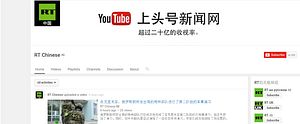In May 2015, a new branch of Russia’s propaganda machine burst onto the scene. Following in the steps of Moscow’s other multilingual platforms — in French, Arabic, and English — RT, formerly Russia Today, announced it was finally broaching the Chinese market. As a release detailed, “RT has stretched across continents to reach out to Chinese-speaking audiences launching a dedicated channel on YouTube.” Or as an RT presenter shared, “Make sure to check out all of our familiar programs translated into [Chinese].”
As the channel passes its two-year mark, however, Moscow may be wondering whether entering the Chinese market was worth the effort, or the funding, it promised. Indeed, in just 24 months of operation, there’s every indication RT’s Chinese component could be the Kremlin’s largest state media-related flop to date — an impressive feat, given that elsewhere RT has captured only 0.04 percent of the British market, and failed to crack the top 94 American cable channels recently surveyed by Nielsen.
All told, RT’s Chinese channel has just over 4,100 subscribers — a meager total, especially when compared to the 850,000 subscribers the outlet has for its Spanish channel, as well as the two million subscribers following its English YouTube channel. Only one clip from RT’s China channel has reached at least 1,000 views in 2017: a two-minute video featuring Peruvian shamans blessing photos of U.S. President Donald Trump and Russian President Vladimir Putin. Indeed, that’s only one of two offerings over the past two years that’s attained at least 10,000 views, the other being a 2016 clip of a Swedish musician playing a marble-based music box.
Far more indicative of RT China’s output are a series of recent clips — on Queen Elizabeth, on Trump dancing in Saudi Arabia — that have scraped together, at most, only a few dozen views. Likewise, where early videos on RT’s China channel were dubbed versions of the outlet’s English-language offerings, it seems RT hasn’t even bothered to dub recent English-language clips featured on its Chinese channel, effectively defeating the entire point of its Chinese vertical.
The failure of RT’s Chinese component is, on the one hand, somewhat surprising, insofar as the potential market is far larger than, say, RT’s German-speaking audience. However, given that RT acts as far more of an arm of the Kremlin’s foreign policy than any kind of independent outlet, the push into the Chinese audience was always a curious move. The timing of RT’s China unveiling was odd, coming as it did alongside the Kremlin’s post-Crimea push to woo Chinese investment and diplomatic support. Given the responses Western governments have had to RT’s presence in their respective domestic markets — just look at how Washington reacted to RT’s role in Russia’s 2016 hacking campaign — there’s little reason to think Chinese authorities wouldn’t at least look askance at RT’s attempt to reach a Chinese market.
Of course, the failure of RT’s Chinese venture may stem from the latest round of budget cuts, coming amidst the longest recession Putin has ever overseen. Or it could simply be Moscow didn’t realize that China decided to block YouTube in 2009 — effectively cutting off China’s domestic market from RT’s Chinese material on the platform, and tossing that many more questions at Moscow’s move to launch a Chinese YouTube channel in the first place.
Two years after RT’s Chinese foray, it’s still possible to catch a clip of Putin playing piano with Chinese captions. But for anyone who wants much more from the outlet’s Chinese vertical, you’re out of luck.

































